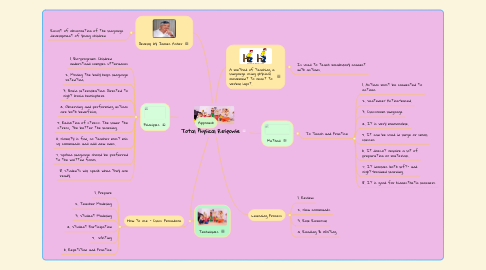Total Physical Response
par Jennifer Sánchez


1. Develop by James Asher
1.1. Result of observation of the language development of young children
2. Principles
2.1. 1. Bio-program: Children understand complex utterances
2.2. 2. Moving the body helps language retention.
2.3. 3. Brain lateralization: Directed to right brain hemisphere
2.4. 4. Observing and performing actions are both beneficial.
2.5. 5. Reduction of stress: The lower the stress, the better the learning.
2.6. 6. Novelty is fun, so teacher must mix up commands and add new ones.
2.7. 7. Spoken language should be preferred to the written form.
2.8. 8. Students will speak when they are ready.
3. Approach
4. Techniques
4.1. How to use - Class Procedure
4.1.1. 1. Prepare
4.1.2. 2. Teacher Modeling
4.1.3. 3. Student Modeling
4.1.4. 4. Student Participation
4.1.5. 5. Writing
4.1.6. 6. Repetition and Practice
5. Learning Process
5.1. 1. Review
5.2. 2. New commands
5.3. 3. Role Reversal
5.4. 4. Reading & Writing
6. A method of teaching a language using physical movement to react to verbal input.
6.1. Is used to teach vocabulary connect with actions.
7. Method
7.1. To Teach and Practise
7.1.1. 1. Actions must be connected to actions
7.1.2. 2. Sentence/ Action-based.
7.1.3. 3. Classroom language
7.1.4. 4. It is very memorable.
7.1.5. 5. It can be used in large or small classes
7.1.6. 6. It doesn't require a lot of preparation or materials.
7.1.7. 7. It involves both left- and right-brained learning.
7.1.8. 8. It is good for kinaesthetic learners
